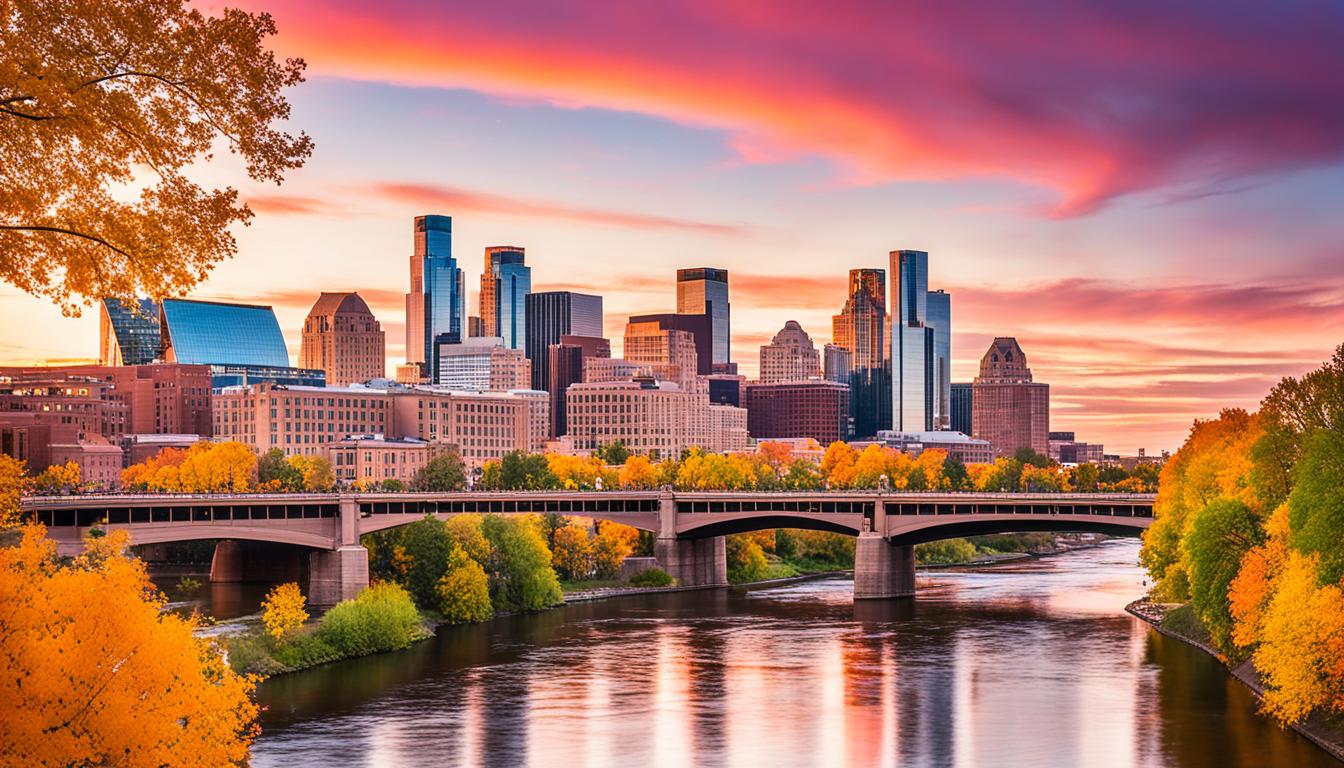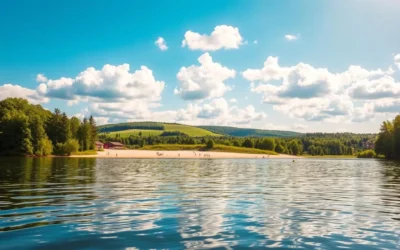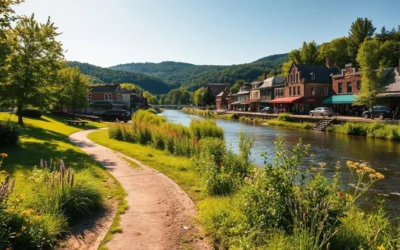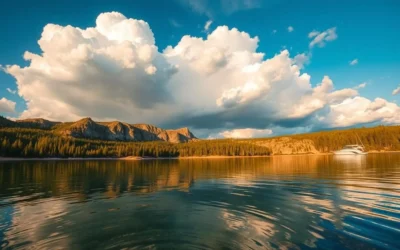✓ Accommodations ✓ Flights ✓ Rental Cars ✓ Tours & Activities
Looking to plan a trip that matches Minneapolis’ weather? Exploring the seasonal changes in the Twin Cities can boost your visit. Whether it’s the intense summer heat or the cold winter winds, knowing when to go can open up great experiences.
Key Takeaways
- Minneapolis experiences hot, humid summers and freezing, snowy winters.
- The ideal times to visit are in late spring and early fall when temperatures are more mild.
- Visitors need to be prepared for the brutal winter conditions, with average highs in the 20s Fahrenheit and lows in the single digits.
- The Minneapolis-St. Paul metro area is the coldest heavily populated area in the U.S.
- Outdoor activities and festivals thrive during the warmer months, while winter offers unique opportunities to embrace the cold.
Understanding Minneapolis’ Seasonal Weather Patterns
Minneapolis has different seasons that bring sunny warmth and icy chills. The summers can get very hot, sometimes over 100°F. Winters are extremely cold, with temperatures frequently below 0°F. The area is known for being the coldest urban spot in the U.S., having winters with temperatures ranging from mid-20s to single digits.
Ideal Times for Visiting: Late Spring and Early Fall
While the city’s weather extremes can be tough, late spring and early fall are perfect for visiting. These times bring mild weather. They’re great for outdoor fun and seeing the sights without the summer crowds.
Surviving the Brutal Minneapolis Winter
Minneapolis is famous for its extremely cold winters. Highs average in the 20s °F, and lows can go to single digits. It’s common to see temperatures below 0°F. The area gets about 60 inches of snow a year, often in heavy blizzards. To endure the Minneapolis winter climate, you must prepare well.
Average Winter Temperatures and Snowfall
By late in the year, December hits an average high of 27°F and a low of 15°F. January cools even more with a 24°F high and a low of 9°F. These average temperatures show why it’s vital to dress warmly and expect quick snowfall amounts.
Essential Winter Packing List
For a winter visit to Minneapolis, gather all your warmest gear. This should include a heavy winter coat, thermals, sweaters, and warm socks. Don’t forget a warm hat, heavy gloves, scarf, and perhaps a ski mask for face protection. Interestingly, you might not need snowboots because the city quickly clears its sidewalks after snowfalls.
Embracing Winter Fun: Festivals and Outdoor Activities
Minneapolis doesn’t let the extreme cold dampen its spirits. It hosts several winter events and outdoor activities. For example, the Holidazzle, Winter Carnival, and Pond Hockey Championships are big hits. The Loppet winter sports festival also draws many. If you love snow sports, you can try cross-country skiing or find slopes for downhill skiing/snowboarding around Minneapolis-St. Paul.
Springtime in the Twin Cities
Spring in Minneapolis doesn’t start quickly. In March, it feels like winter still. April gets a bit warmer, soon short sleeves are needed. May finally signals the start of summer. This shift has many changes in temperatures, creating a freeze-thaw cycle in the Minneapolis Spring Climate and Transitional Weather.
The Slow Arrival of Spring Weather
The Freeze-Thaw Cycles of spring in Minneapolis can be tricky. It confuses visitors on what to wear. The city surprises with big temperature changes and even snow in late spring.
Recommended Spring Attire
In spring, the advice is to start with a light down jacket in March. Move to jeans and short sleeves as April comes in. For May, add shorts, sandals, and lots of layers. Bring a light sweater, raincoat, and an umbrella. The right Spring Packing List and Suitable Footwear are key to enjoying the city’s Transitional Weather.
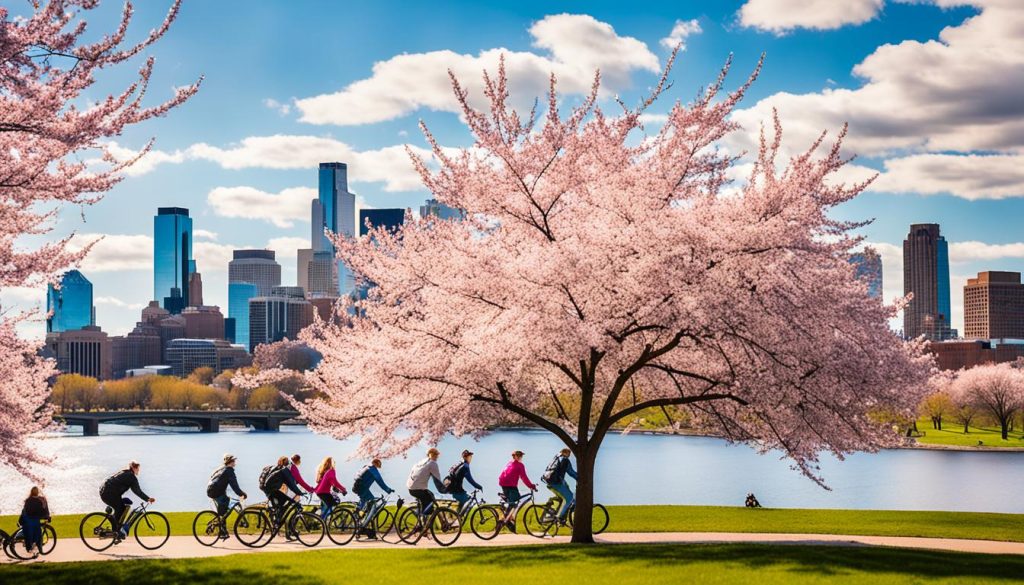
Sizzling Summer Months in Minneapolis
In summer, Minneapolis turns into a lively hot spot. With soaring temperatures and rising humidity, things get busy. Even when it’s not so hot, the humidity can make it feel uncomfortable. Locals also have to deal with mosquitos buzzing around.
To cool off, the city gets seasonal storms. These bring showers and thunderstorms. It’s wise to plan your packing with these weather changes in mind.
Summer Packing Essentials
When you visit Minneapolis in summer, light clothes are a must. Pack things made of moisture-wicking fabrics that keep you cool. This includes shorts, t-shirts, and loose dresses.
For walking around, wear comfy shoes like aerated sneakers or sandals. Also, pack sun protection like sunglasses and a hat, plus a waterproof windbreaker. These will protect you from the sun and quick rain showers.
Remember your insect repellent to keep mosquitos away. They’re part of Minneapolis summers too.
Minneapolis, Minnesota: Best Months for a Weather-Savvy Trip
Fall Colors and Cooler Temperatures
Fall is a brief but celebrated season in Minneapolis, according to locals. This time, the autumn climate starts to dominate, and by November, it feels almost wintry. As for sights, the scenery becomes a vibrant mix of gold and crimson by early October. It’s the perfect time for fall foliage lovers and those into outdoor activities.
Ideal Autumn Wardrobe
Your bags for Minneapolis should see an ideal autumn wardrobe, says the first source. Early in September, you might get by with light clothes. However, by October, it’s wise to add some layers. And when November rolls in, expect to bundle up with jackets and winter accessories. Thinking about layering strategies while packing ensures comfort during the city’s ideal fall visit time.
Monthly Temperature, Rainfall, and Daylight Hours
Learning about the Minneapolis Climate Data is key for a great trip to the city. It tells you about the Monthly Weather Averages and Precipitation Patterns. Knowing these helps you enjoy your time in Minneapolis more.
The July is the hottest month in Minneapolis, reaching an average high temperature of 74°F. On the other hand, January is the coldest month, with average highs of 24°F and lows of 9°F. June, July, and August see the most rain, about 4 inches each month.
In December, the city gets the least daylight, only 9 hours. But, June and July have the most, with up to 15 hours of sunlight. These changes are important to think about when planning what to do in Minneapolis.
| Month | Average High (°F) | Average Low (°F) | Rainfall (inches) | Daylight Hours |
|---|---|---|---|---|
| January | 24 | 9 | 1.0 | 9 |
| February | 29 | 13 | 0.8 | 10 |
| March | 39 | 21 | 1.9 | 11 |
| April | 54 | 33 | 2.6 | 13 |
| May | 66 | 44 | 3.4 | 14 |
| June | 75 | 54 | 4.1 | 15 |
| July | 74 | 61 | 4.0 | 15 |
| August | 72 | 56 | 4.0 | 14 |
| September | 67 | 47 | 3.0 | 12 |
| October | 54 | 36 | 2.2 | 11 |
| November | 41 | 25 | 1.7 | 10 |
| December | 27 | 15 | 1.2 | 9 |
This detailed info on Minneapolis Climate Data is useful for planning your Twin Cities trip. It helps you pack and plan for any weather you might face year-round.
Preparing for Winter Travel
Visiting Minneapolis in winter means facing tough driving. The second source says it’s smart to stay off roads during snowstorms. If you must drive, slow down and look out for black ice hazards on unplowed roads.
Driving in Winter Conditions
Be familiar with Minneapolis’ snow removal rules to avoid having your car towed. Know how to drive on icy, snowy streets. Begin and stop slowly to keep your car in control.
Checking Weather Forecasts and Warnings
Keep up with local weather updates to stay safe in Minneapolis during winter. The second source suggests watching weather forecasts. Snowstorms can be predicted days ahead. Be alert for blizzard and wind chill alerts that make cold worse.
Being ready for winter weather will make your trip to Minneapolis better. You’ll get to enjoy the season and the city safely. Make the most out of the beautiful winter views.
Embracing Winter Outdoor Adventures
Get ready to enjoy winter in Minneapolis! The Minneapolis-St. Paul metro area is filled with fun winter sports and activities. It’s the perfect place to leap into the snowy season.
Cross-Country Skiing and Downhill Skiing Opportunities
Minneapolis boasts top-notch cross-country skiing trails. These trails are among the best in the nation. You can ski through beautiful local parks and nature preserves. For a bit more excitement, try downhill skiing and snowboarding at places like the famous Spirit Mountain, just three hours away.
Enjoying Fresh Snowfall and Sledding Hills
Even when it’s cold, there’s a lot of fun to be had in Minneapolis. After it snows, walk around or have fun playing in the snow. You can also visit great sledding spots like Columbia Park Golf Course and Battle Creek Park. They’re perfect for fast rides down the snowy hills.
Getting to Downtown Minneapolis from the Airport
Getting from the Minneapolis-Saint Paul International Airport (MSP) to downtown Minneapolis is easy. You have several public transit options and driving directions to choose from, ensuring a smooth trip.
The METRO Blue Line light rail is very handy for this journey. Located inside the airport, it’s easy to find. This line takes you directly into downtown, stopping at many scenes you’ll want to see.
But if you prefer driving, here’s how to get there by car:
- Start by heading north on Interstate 494 for 5 miles.
- Then, pick up Interstate 35W south for around 7 miles.
- Finally, choose the 3rd Street/Downtown exit and follow signs to your destination.
The airport is about 12 miles from downtown. By car, the journey usually takes between 20 and 30 minutes. Do watch out for road closures or construction updates that might slow you down.
| Transportation Option | Estimated Travel Time | Approximate Cost |
|---|---|---|
| METRO Blue Line Light Rail | 25-30 minutes | $2.50 (single fare) |
| Driving | 20-30 minutes | Varies based on parking fees |
| Taxi or Rideshare (Uber/Lyft) | 20-30 minutes | $30-$50 |
No matter how you choose to travel, you’ll have a quick and efficient path to downtown from the Minneapolis-Saint Paul International Airport.

Budget-Friendly Weekend Itinerary
Minneapolis can be explored without breaking the bank. It’s filled with free things to do, cheap places to eat, and entertainment that won’t cost too much. Start your trip with a budget-friendly place to stay. The Moxy Downtown and the 300 Clifton bed and breakfast are good choices. They are recommended for their prices by the third source.
Affordable Accommodation Options
The Moxy Downtown, under the Marriott Bonvoy name, is great for young travelers. It features free drinks and fun happy hours. For something more historic, the 300 Clifton bed and breakfast is a huge mansion. It’s in the Loring Park area, close to downtown.
Exploring Art, Parks, and Local Attractions
There’s a lot to see in Minneapolis for free. The Minneapolis Sculpture Garden has 40+ art pieces and lovely gardens. Don’t miss the Mill City Ruins, Stone Arch Bridge, and Father Hennepin Bluff Park. They’re all next to the beautiful Mississippi River. Plus, the Minneapolis Institute of Art and the Weisman Art Museum don’t charge for entry.
Dining on a Budget
Food in Minneapolis doesn’t have to be expensive. Try Punch Pizza for Neapolitan-style pies or Lotus Restaurant for Vietnamese dishes. The Weinery offers tasty hot dogs and burgers. Bull’s Horn has great bar food. For a taste of the world, visit the Midtown Global Market. It has affordable food from many different cultures.
Theater and Entertainment Options
Minneapolis has a lively theater scene. Go see a show at places like the Mixed Blood Theater, Jungle Theater, or Theater in the Round. They offer close-up experiences that cost less. The Dinkytown area near the University of Minnesota is also full of inexpensive dining and fun options.
Conclusion
Minneapolis is a special place that changes with the seasons. It goes from brutally cold in winter to sizzling hot in summer. This Minnesota city perfectly handles all kinds of weather. By knowing what to pack, you can enjoy everything from the stunning fall foliage to lively outdoor festivals.
If you love winter sports like skiing or sledding, or rather sunbathe in summer at the river parks, Minneapolis has it all. This guide helps you plan your perfect trip, no matter the season. Get ready for an ideal Minneapolis getaway that fits your style and the weather.
So, start packing your bags and get ready to discover the unique charms of Minneapolis. This city lives and breathes its weather, making it truly special. It invites you to immerse yourself in its vibrant culture at any time of the year.
FAQ
What are the best times of year to visit Minneapolis?
What is the weather like in Minneapolis during the winter months?
What should visitors pack for a trip to Minneapolis in the winter?
What are some popular winter festivals and outdoor activities in Minneapolis?
How does the weather in Minneapolis change throughout the spring season?
What is the summer climate like in Minneapolis?
What should visitors pack for a summer trip to Minneapolis?
What is the best time to see the fall colors in Minneapolis?
What are the average monthly temperatures, rainfall, and daylight hours in Minneapolis?
What should visitors know about driving in Minneapolis during the winter?
What are some budget-friendly accommodation and activity options in Minneapolis?
The above is subject to change.
Check back often to TRAVEL.COM for the latest travel tips and deals.
